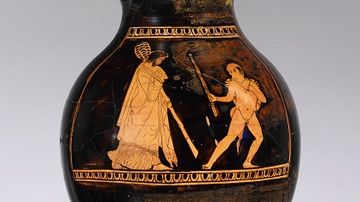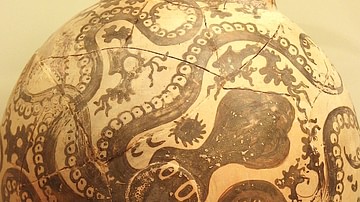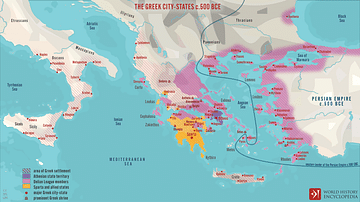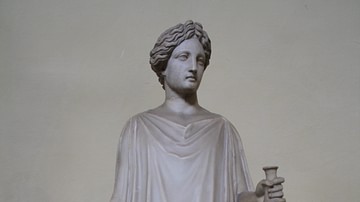Sacred cakes in ancient Greece were baked loaves, biscuits, pastries, and sponges sweetened with honey (meli) and prepared as unburnt offerings to the gods and goddesses and other divine beings. Unburnt offerings were substitutes for or a complement to animal sacrifices whose bones and fat would then be burnt on the altar while their meat would be served in a cultic feast.

The Greeks baked cakes and other kinds of sweetmeat for both religious events and dinner parties since at least the late Minoan civilization in the 2nd millennium BCE. Like what we may find in a bakery shop today, Hellenic ovens around the Greek world could give out sweet rolls, sponge cakes, cheese-pies, flatbreads, pastries, twists, and even layered cakes in a variety of shapes and sizes. The cakes could be made from different sorts of wheat or barley flours, combined with additional ingredients particularly cheese, herbs, fruits, and sesame seeds, and filled or decorated with fruits and nuts. Greek sacred cakes were offered to the gods and goddesses, or even to the kings and heroes commemorated and immortalised as city founders, saviours, and ancestors. They comprised a chief category of votive gifts used in both private and public sacred rituals, where they were carried in ceremonial processions by people who were specially selected for this role. Bringing sacred cakes or their clay models to a shrine or temple was also common in daily prayers or thanksgiving.
Needless to say, ancient cakes do not leave archaeological remains as such. However, we can find a vast range of their artistic representations in frescos, vase paintings, and sculptures. Greek classical writers such as Homer, Hesiod, Herodotus, Euripides, Aristophanes, Pindar, and Athenaeus touch upon various kinds of cakes and desserts in their accounts of religious celebrations or dinner parties that are sometimes furnished with mouth-watering recipes. Sacred cakes may also appear in the lists of offerings carved in stone, clay, or metal tablets. This diverse reflection of sacred cakes in ancient Greek art and material culture continued throughout the Classical Period (c. 480 to c. 323 BCE) and culminated in the Hellenistic Period (c. 323 to c. 31 BCE) when it finally left its mark on the Roman cuisine. An example of this bake-off impact is the development of the Roman cheese flatbread, placenta, from the Hellenic layered cheesecake, plakous, which has inspired some researchers to peck on both as probable precursors of pizza. It is also suggested that Greek sacred cakes may contain the ancient roots of wedding cakes, birthday cakes, and the tradition of putting candles on the top of the latter.
Baking and other kitchen works were considered a woman’s job, regardless of her social position or monetary situation, as understood from many painted and sculpted depictions of baking women in ancient Greece with or without jewellery who all wear the casual sleeveless peploi and keep their hair out of the way under a head cap called kekryphalos. On the other hand, we also have pictures and statues of male bakers reminding us of a few written indications of industrial baking, for example by the Greek philosopher Plato (l. 428/427 - 348/347 BCE) who believed in men’s superiority over women in every imaginable respect, including "weaving and the watching of pancakes" (Republic 5.455c), and saw the pinnacle of an oven artisan in Thearion who could provide "admirable loaves" (Gorgias 518c).
Greek Bake-off in Archaeology
Whilst ancient writings and visual evidence cast a good amount of light on cakes and baking in ancient Greece, it is not always easy to link a certain cake name to one specific cake-looking shape. Undoubtedly, we may find many names suggestive of what their associated cake must have looked like (e.g. pyramis = pyramid), and they may even tell us about when and/or where the cake would be offered (e.g. elaphos = deer-shaped cake offered to Artemis in the spring month of Elaphebolion). Some writers, however, simply refer to a sacred cake by some generic name such as melotoessa (honey-cake), plakous (cheese-pie), pemma (sweetmeat), or pelanos (sacrificial cake). Therefore, researchers often prefer to study Greek sacred cakes in the context of a cultic practice or event.

Clay figurines demonstrating various stages of the baking process have been retrieved from many places around the Hellenic world, including Athens, Boeotia, Carthage, Cyprus, Crete, and Akanthos on the Athos peninsula not far from Thessaloniki. Apart from grinding grains and kneading or rolling the dough, these figurines reveal different forms of in-ground fire holes and free-standing ovens that were common around the Mediterranean world up to this day. The earliest Greek bake-off figurines date back to the Archaic Period in the 1st millennium BCE.
An even earlier illustration of sacred cakes, however, is visible on the Hagia Triada sarcophagus from Crete, c. 1400 BCE. One of the longer sides of this limestone coffin is decorated with a colourful painting of a sacrificial scene. The highlighting point of this ceremonial picture is a young woman, perhaps a priestess, resting her both hands on an altar in the gesture of placing down an offering and/or leading the prayers. She looks up to a basket of white and red round cakes hanging in front of her face and within her reach. A second row of similar cakes is also lined up on the main altar, whose importance is emphasised by four pairs of sacred bullhorns.
Some scholars have suggested that the round 'cakes' may in fact represent fruits, a point that remains obscure in the current absence of readable texts from the Minoan culture. Still, it is notable that many sacred cakes in ancient Greece were actually made of, filled with, or shaped like fruits. A prominent example is pankarpia, a round cake whose name means "all fruit". This was a piece of dough enriched with sesame seed and boiled in honey, which made the dough plump up and form a glazing and crispy crust like a doughnut. Pankarpia had a special place in agricultural festivals celebrating Zeus Ktesios (who presided over planted seeds) and Zeus Georgos (who helped the farmers, particularly in the harvest).
Sacred Cakes in Myth & History
Pausanias, the 2nd-century CE Greek geographer, ascribes the introduction of cakes into sacred rites to Kekrops, the mythical king and founder of Athens who was also revered for teaching people several practices characteristic of civilised life such as literacy, marriage, and religious rites. Kekrops is known to be the first Greek ruler who acknowledged Zeus as the highest among the gods of Greek mythology and established a state cult for him. To edify the savage ways of worship, Kekrops replaced the ritual bloodshed of animals, especially the bulls, with the bearing and offering of bull-shaped cakes called the pelanoi. As a result, the pelanos became a sort of national cake to the Athenians, and its name was later used as a generic term for sweet rolls (8.2.3).

Kekrops was also the mythical witness who secured Athena’s victory over Poseidon in their competition for the patronage of Athens, according to one of the several variations of the story (Pseudo-Apollodorus, Bibliotheca 3.14.2). He told the twelve Olympians, who had been summoned by Zeus to stand as the judges, that Athena had managed to plant her eternal olive tree before Poseidon had a chance to strike the hill by his trident to jet out saltwater. As Kekrops was born half man and half serpent, he bore the title of 'snake king' supposedly embodied in the oikouros ofis or 'household snakes' that resided in the temple of Athena on the Acropolis. Herodotus writes, doubtfully, that the Athenians believe in a big snake living there as the guardian of their city. They feed it with monthly offerings of honey-cakes (melitoessa) and take the consumption of the cake as a blessed omen. Therefore, during the Second Persian Invasion of Greece, when the priestess of Athena announced that the snake had apparently refused the cake, the Athenians, horrified by this sign of Athena’s withdrawal from her protecting capacities, evacuated the city (8.41.2-3).
Sacred Cakes in Religious Rituals
The cultic rituals of worshipping the Greek gods, goddesses, and other immortalised figures often involved a procession with choral dancing or rhythmical proceeding. Carrying sacred objects and votive gifts in such processions was a role often given to carefully selected people from citizens of noble birth and descent reputation. Young girls of exemplary manners and beauty were particularly appointed to deliver sacred cakes, perhaps because it gave them a platform to attract the best suitors with their dancing and balancing skills. The role of the cake-bearer could also be fulfilled by younger priestesses who served in a shrine or temple.
The largest group of votive cakes appear on the Athenian little wine jugs (choetes; sing. chous) that were typically given to 3-year-old children as a present at the Anthesteria festival. This three-day celebration was an end-of-winter (February/March) festival of opening the jars of new wine (fermented from the grapes of the last harvest) and feasting on them with Greek dance and song and giving thanks and praise to the god of wine, Dionysos. Little choetes were decorated with pictures of children (mostly but not exclusively boys) playing with or around ritual objects, including sacred cakes.
When women appear in these paintings, they may carry or sell round loaf-shaped cakes corresponding with the omphalos (navel or knob) cake sometimes with a central knob on the top. Bigger flat loaves, particularly with one or more pairs of crossed lines cut on their upper crust, may represent the plakous, a layered cheesepie flavoured with fruits, nuts, or herbs. This cake was later adopted by the Romans as the placenta cake, and its widespread popularity in ancient Italy has inspired assumptions about its being the ancient forerunner of pizza.
Both the omphalos and the plakous have strong ties with the concepts of (re)birth and fertility, widely personified in Demeter and her daughter, Persephone, the spring goddess. Along the same lines, an important spring festival was the Mounichia, held around the 16th or 17th of the Athenian month Mounichion (roughly corresponding with 27 to 29 April) at the time of the full moon. Artemis Mounichia as the moon goddess was offered trays of layered cakes, called the amphiphones (the two lights or double lightings), topped with a round of little torches (dadia).
Again, there are a good number of Greek vase paintings bearing the pictures of young women in their best clothes and ornaments who carry these amphiphon-trays while dancing their way forward in a spring-time celebration. Like with the placenta, there are some firm assumptions about historical ties between the amphiphon and the practice of putting candles on our birthday cakes today.

Sweet Impacts
In the Hellenic religious culture, offerings were divided into three categories:
- burnt or blood sacrifices which included animal killing at the altar and burning their fat and bones,
- unburnt offerings ranging from edible stuff such as grains and cakes to garments, statues or models, meaningful objects, etc.
- libations – wine or water poured down, sometimes on the altar.
Food offerings were then served to the worshippers, both clergy and lay, who sat down to eat together as a sign of belonging to the same fellowship, to strengthen their sense of unification and companionship, and to integrate with the worshipped deity through eating the cake or bread, which symbolised his or her material incarnation. Although the ritual practice of developing an inner connection with a deity through eating symbolic pieces of their body does not start with the Greeks in ancient history, its adoption by later religions such as Christianity is a visible effect of the Greek cultural influence in the Roman Empire and beyond.








